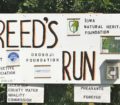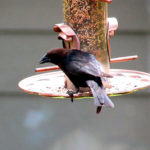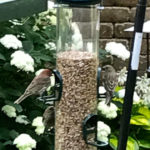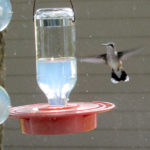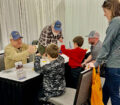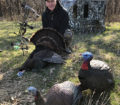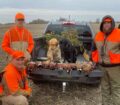- Adult male cowbird
- Finches at the NutraSaff seed
- Hummingbird taking a break from feeding
- Hummingbird hovers at the window nectar feeder
By Darial Weisman
Each year brings its share of surprises for those of us who faithfully feed our birds. With a variety of feeders to attract a wide range of birds, we get so many different types of birds to enjoy their special treat each day. From hummingbirds, to purple finches, to gold finches, to chipping sparrows, to chickadees, to nuthatches, to downy woodpeckers, to red-bellied woodpeckers, to robins, to mourning doves, to orioles, to rose-breasted grosbeaks to cardinals…they appear daily. Bunches of them!
However, this year there was one that was totally different and totally unexpected. And there was only one for a reason. It showed up about mid-June. It was a young-of-the-year brown-headed cowbird, a member of the blackbird family. It is most unusual, because it usually appears shortly after it learns to fly. However, it is with no other cowbird. Instead, it is accompanied by another species of birds.
The reason? The cowbird female is what is called a brood parasite. According to the Audubon Society, this means “That rather than raise their young themselves, they ditch their eggs in other species’ nests and allow these forced foster parents to do the tough work of chick-rearing. Baby cowbirds grow up with families that neither look nor act anything like them—sometimes in habitats in which cowbirds typically don’t even live.”
Often the incubation period is shorter than the host’s eggs, and the cowbird chick will often grow faster than the other offspring. This often leads to monopolizing much of the food and reduced nesting success for the host.
Well, going back to mid-June when we watched a juvenile cowbird come to the feeder and sit and wait for its foster parent to feed it. Suddenly in flitted a little purple house finch, its foster parent. Literally a third the size, the little finch began to feed it. That certainly was quite a sight. This big cowbird youngster towered over its poor “mother!” Comical, yes! Yet, it was a pretty tough assignment for the little finch.
It stayed around eating seed off the ground and eating from the platform feeder before, I guess, it figured out it was a cowbird, and took off. Luckily for the purple finch, its foster parent job was over! Since we only seem to get one or two of these each year (along with an adult from time to time), we have not taken down our platform feeder or changed any of our selection of seeds, because the system works for so many other birds. Unfortunately, I never had the camera handy when the youngster was around, but I did get one of the adult male.
Talking about bird seed
We’ve used safflower seed for a lot of years with good results. However, a few weeks ago, after visiting with Wendell Hansen at Bird Haven, we chose to try a new type of safflower called NutraSaff safflower seed. Instead of the normal white color, the NutraSaff is a golden brown. Wendell told us he tried the product himself around three years ago as an experiment and gave out five-pound samples to some of his customers. They all agreed that the NutraSaff worked extremely well (better than traditional safflower) and attracted a lot of different birds.
Since we began using NutraSaff, we have more consistently gotten cardinals and rose-breasted grosbeaks to our large cylinder (tube) feeder. Here is what we found about NutraSaff. It has an extremely thin outer hull, which makes it easier for the birds to eat and digest. It has 15 percent more oil content, 25 percent higher protein and 30 percent higher fat content (energy) than traditional safflower seed. We have also found that there is less waste than with traditional safflower seed.
It is also supposed to deter squirrels and grackles!
Migration to begin
Crazy, isn’t it? By this time of year, many of our summer birds begin to think about migrating south. One of the birds we really enjoy is the hummingbird migration. Even if you haven’t been feeding hummingbirds, it’s not too late. As a matter of fact, with the influx of hummingbirds migrating through, you might be surprised just how many you will be able to attract. I would suggest going to your local bird feeding store to pick one out. It seems like everyone has their favorite. We actually have two out because of the influx during this migration time. Next comes selecting hummingbird feed-nectar. You can purchase nectar from the store, but it is really easy to make “sugar water.”
Nectar
The best part about hummingbird food is that the nectar is extremely easy to make and store. It’s a homemade recipe, and I definitely believe that hummingbirds prefer it to the store bought mixes. Here is the recipe:
- 1 part sugar
- 4 parts water
- Boil the sugar water until the sugar dissolves and the water is clear (usually takes 1-2 minutes).
- Cool and store in the refrigerator if you are going to use it that week (if the mixture becomes cloudy, do not feed it).
- Freeze it in containers for later use – this is a great way to always have sugar water (nectar) on hand. When you are ready for more nectar, simply remove the container from the freezer, allow the mixture to thaw out and then pour it into the feeder.
Keep things clean
This is really important. The hummingbird feeders need to be cleaned, even in the fall. One way to tell if it is time is if the normally clear nectar is becoming cloudy. If you wait too long, you can have mold. Definitely a no-no for the hummingbirds! Personally, I don’t fill my feeders full, because it’s difficult for the hummingbirds to use up all of the nectar before it’s time to change the nectar and clean the feeders.

